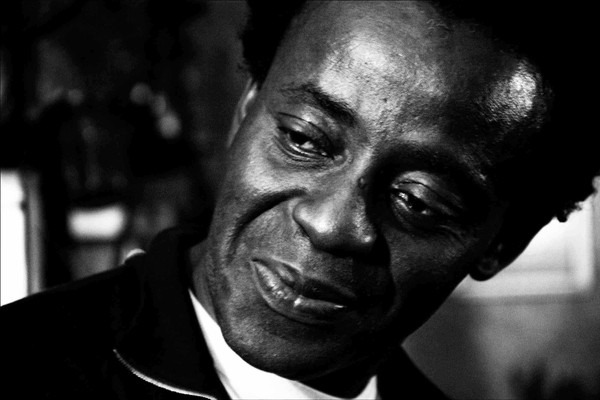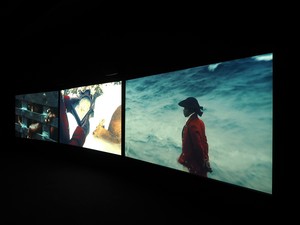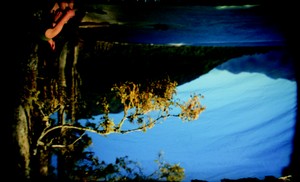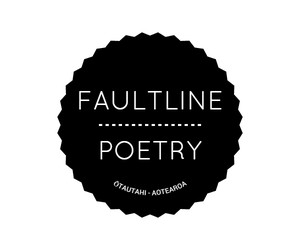John Akomfrah
Vertigo Sea
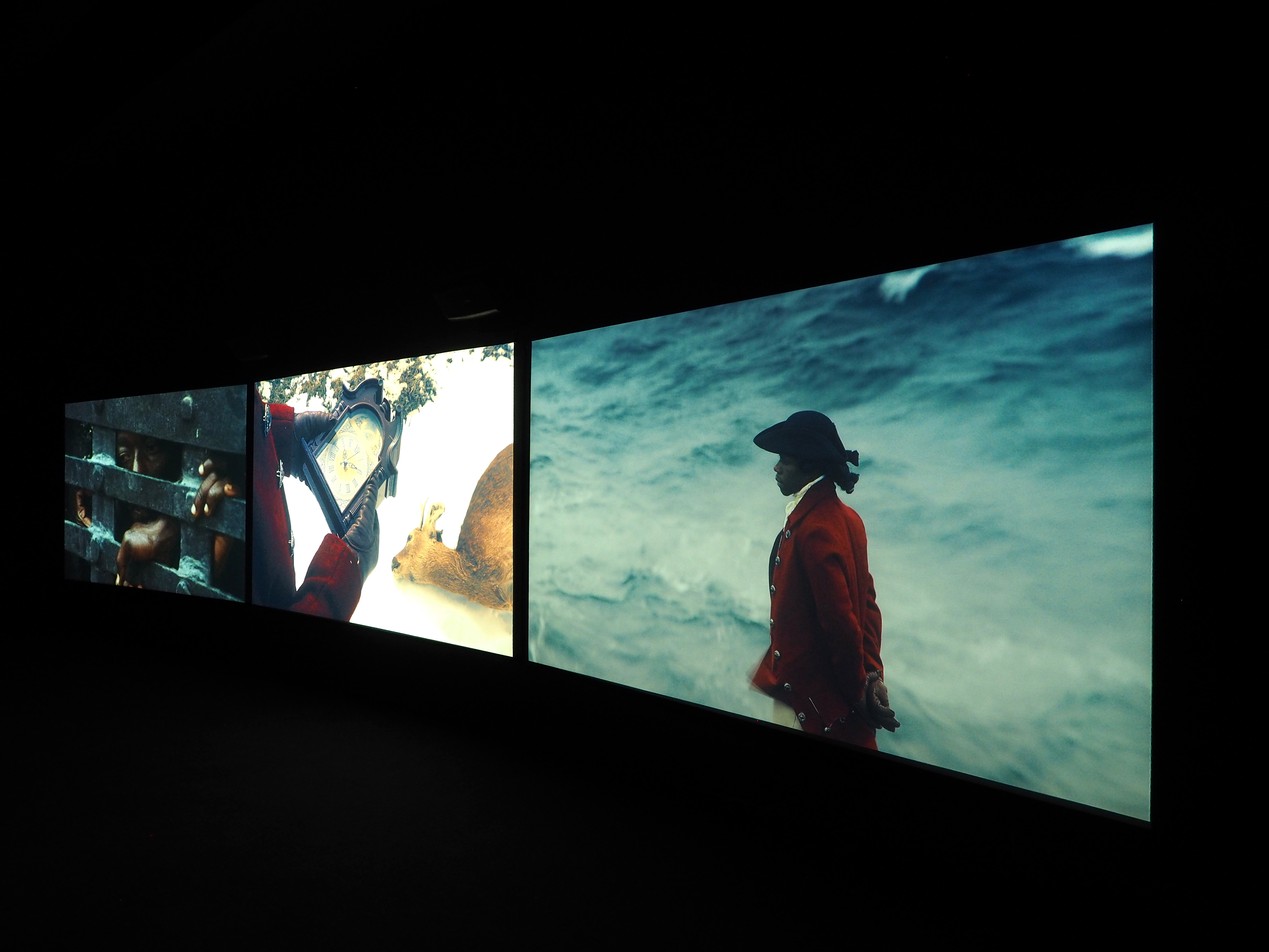
John Akomfrah
Vertigo Sea
Vertigo Sea, a three-screen film, first seen at the 56th Venice Biennale 2015 as part of Okwui Enwezor’s All the World’s Futures exhibition, is a sensual, poetic and cohesive meditation on man's relationship with the sea and exploration of its role in the history of slavery, migration, and conflict.
Fusing archival material, readings from classical sources, and newly shot footage, the work explicitly highlights the greed, horror and cruelty of the whaling industry. This material is then juxtaposed with shots of African migrants crossing the ocean in a journey fraught with danger in hopes of ‘better life’ and thus delivering a timely and potent reminder of the current issues around global migration, the refugee crisis, slavery, alongside ecological concerns.
Shot on the Isle of Skye, the Faroe Islands and the Northern regions of Norway, with the BBC’s Bristol based Natural History Unit, Vertigo Sea draws upon two remarkable books: Herman Melville’s Moby Dick (1851) and Heathcote Williams’ epic poem Whale Nation (1988), a harrowing and inspiring work which charts the history, intelligence and majesty of the largest mammal on earth.
Akomfrah was a founding member of the influential Black Audio Film Collective, which started in London in 1982 alongside the artists David Lawson and Lina Gopaul, who he still collaborates with today. Their first film, Handsworth Songs (1986) explored the events surrounding the 1985 riots in Birmingham and London through a charged combination of archive footage, still photos and newsreel. The film won several international prizes and established a multi-layered visual style that has become a recognisable motif of Akomfrah’s practice.
MORE INFORMATION ABOUT VERTIGO SEA
Vertigo Sea, a powerful three-screen film installation, invites us to reflect upon humankind’s relationship with the sea. The artist describes the work as a eulogy, commemorating lives lost at sea. It is a work that takes the viewer on an immersive journey touching on the greed and cruelty of the whaling industry, the transatlantic slave trade and the current refugee crisis. Part fiction, part natural history documentary, Vertigo Sea fuses archival footage with newly shot material and readings from classic literature to create a moving narrative. The film could be described as a tapestry of empathy: a compelling web of interrelated concerns, histories and traumas connecting to our interactions with the sea.
“I wanted to make a work that spoke to [these] concerns of memory, of historicity, migration and possible futures”. John Akomfrah, 2015
The sea is a reoccurring motif in John Akomfrah’s work, providing a rich source material through which his interest in movement and displacement can be explored. Vertigo Sea is presented as an expanded visual ‘essay’, an approach that uses images and the relationship between them to explore themes or create narratives.
The inspiration for the work came from a radio interview with a group of young Nigerian migrants who had survived an illegal crossing of the Mediterranean. They expressed the feeling of being faced by something vaster and more awesome than they had thought possible. While the sea is mesmerising, universally compelling and beautiful, it is also a uniquely inhospitable environment. It is difficult for us, as humans used to having control over our surroundings, to grasp the enormity of this constantly changing element, and the word ‘vertigo’ perhaps refers to this unfathomable reach.
To create the film, Akomfrah edited together footage from a wide range of sources and periods, an approach that he has developed over the course of his career, which dates back to early work that he made in the 1980s as part of the Black Audio Film Collective. He has described the act of ‘image taking’ – capturing an image of the present for the future – as having an ‘almost sacred’ aspect, in that it assures an afterlife. In handling this material there is great responsibility, since the role of the artist or editor becomes that of a custodian of our future.
The dreamlike quality of Vertigo Sea mirrors the subject of the piece. Shot on the Isle of Skye, in the Faroe Islands and Northern regions of Norway, the film depicts the exceptional beauty of the aquatic world. The BBC Natural History Unit in Bristol supported the development of the work with unique access to its archive, presenting the ocean as a primordial life source. However, the underpinning themes are of bereavement, suffering and dislocation: a cultural history of mankind at sea as both victims and perpetrators.
In an early section of the film, audio recordings of migrants are played over footage related to the plight of the Vietnamese boat people. Thousands of these migrants drowned in their desperate attempt to escape persecution after the Vietnam War, an echo of our current crisis that is largely ignored in the media. Akomfrah is interested in that amnesia and how traumatic collective acts and memories are often forgotten or disregarded by society, meaning we are forever repeating history.
The heritage of the millions of enslaved Africans shipped away from their homelands across the Atlantic ocean is also exposed in this film, with particular reference to the Zong massacre of 1781, an act of mass murder of slaves aboard a stranded ship for the purpose of claiming insurance money against their loss.
There are poignant connections between these histories and that portrayal of the whaling industry within the film. Akomfrah draws upon two significant books directly related to the subject: Herman Melville’s Moby Dick (1851), with its sense of the impermanence and precarious nature of life, and Heathcote Williams’ epic poem Whale Nation (1988), a harrowing but inspiring work which charts the history, intelligence and majesty of the largest mammal on earth.
“The gunners themselves admit that if whales could scream the industry would stop, for nobody would be able to stand it.” Dr. Harry D. Lillie who served as a physician on a whaling ship in the 1940s.
Like the slave trade, whaling has been a violent though hidden undercurrent instrumental to western industrialisation. Street lighting of the major cities of Europe and North America was provided by burning whale oil in the 19th century, while in the 20th century it was widely used in products ranging from margarine to makeup. These creatures, which biological research has shown to have human-like intelligence, were hunted to near extinction by people who were themselves often exploited, living for years at a time on dangerous, trans- oceanic hunting expeditions, earning little pay and often falling into debt with the whaling companies.
Although the comparison of whales’ intelligence to that of humans has been the most influential argument in support of a ban on whaling, there is a troubling contrast in the recent labelling of sea-crossing refugees as ‘cockroaches’ in the media, a reflection of the limits of society’s compassion for human suffering.
Akomfrah has spoken about the importance of maintaining the open-endedness of found images, rather than imposing specific meaning. Positioned alongside archive film, the newly shot footage in the film appears symbolic: in these sections, ambiguous figures dressed in clothes from a range of historical periods are shown looking out to sea. There is a sense that they are waiting, perhaps for the consequences of traumas from the past, or in anticipation of a mythical flood that promises to wipe out humanity for its sins.
“Be not the slave of your own past. Plunge into the sublime seas, dive deep, and swim far, so shall you come back with self- respect, with new power, with an advanced experience that shall explain and overlook the old.” Ralph Waldo Emerson, 1838
Vertigo Sea has been described by the artist as a series of lamentations or elegies. It includes some harrowing content, but is not intended to leave us in a state of despair. The film presents its story as a universal, humane concern – something to move us to compassion, rather than freeze us with horror.
Text Credit: Arnolfini, a centre of contemporary art based in Bristol UK.

John Akomfrah
Vertigo Sea, 2015
Three channel colour video installation, 7.1 sound
48 minutes 30 seconds
Vertigo Sea, John Akomfrah
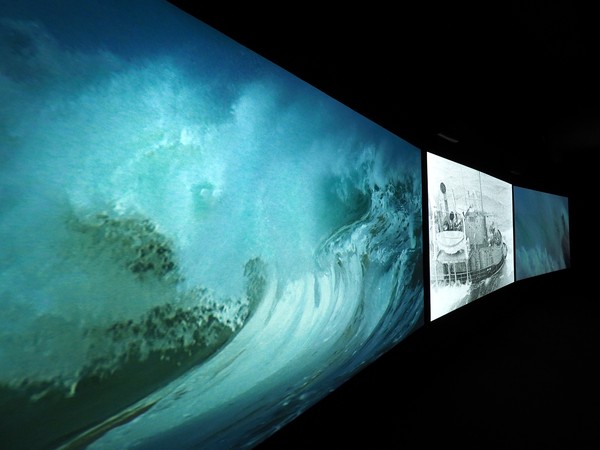
John Akomfrah
Vertigo Sea, 2015
Three channel colour video installation, 7.1 sound
48 minutes 30 seconds
Vertigo Sea, John Akomfrah
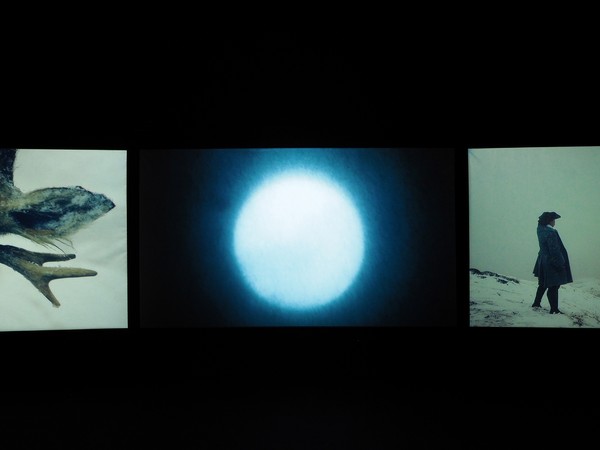
John Akomfrah
Vertigo Sea, 2015
Three channel colour video installation, 7.1 sound
48 minutes 30 seconds
Vertigo Sea, John Akomfrah
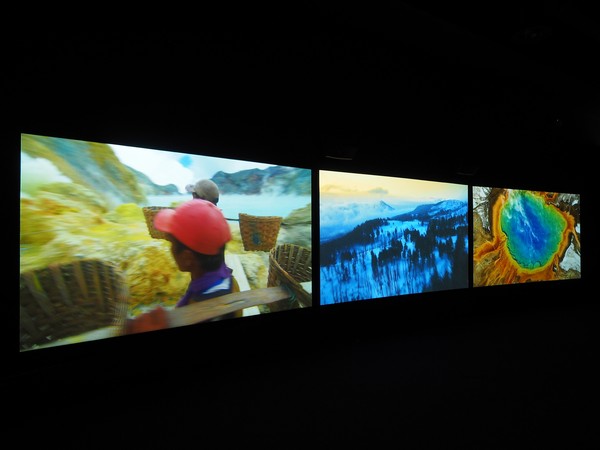
John Akomfrah
Vertigo Sea, 2015
Three channel colour video installation, 7.1 sound
48 minutes 30 seconds
Vertigo Sea, John Akomfrah

John Akomfrah
Vertigo Sea, 2015
Three channel colour video installation, 7.1 sound
48 minutes 30 seconds
Vertigo Sea, John Akomfrah
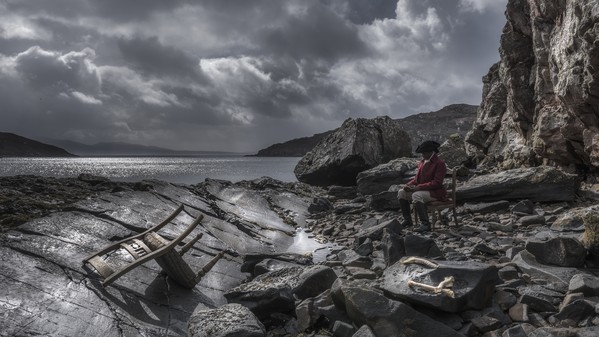
John Akomfrah
Vertigo Sea, 2015
Three channel colour video installation, 7.1 sound
48 minutes 30 seconds
Vertigo Sea, John Akomfrah
